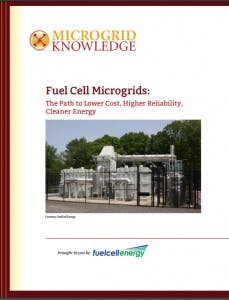University Achieves 20 Percent Savings with Smart Financing and a Fuel Cell Microgrid
A fuel cell microgrid now supplies 80 percent of the power for critical facilities at the University of Bridgeport and cuts the energy costs by 20 percent during normal operations, as explained in this case study from “Fuel Cell Microgrids: The Path to Lower Cost, Higher Reliability Cleaner Energy.”
Spiritualist drawing rooms in 19th century Bridgeport were replete with ethereal energies. One stately salon in this seaside Connecticut community ‘saw’ a restless spirit mimic the sound of a hissing steam engine and cause the sense of strong currents of air rushing through the closeted room.
Somewhat more sedate, thankfully, modern Bridgeport is home to complex energies of a different sort.
The University of Bridgeport (UB), with its campus located on Long Island Sound, has more than 5,500 students. Its online degree programs have consistently ranked among the top 15 or so in the country. And the school partnered with the Peace Corps in 2014 to offer New England’s first Peace Corps Preparatory Program.
Now the small private university is set to add another feather to its cap: It is home to a highly innovative— and positively energetic—financing and operational business model for microgrids.
First, Connecticut-based fuel cell manufacturer FuelCell Energy built the university’s 1.4 MW microgrid. Then it sold the project to generation giant NRG Energy. The all-cash deal was structured under a power purchase agreement (PPA) arrangement, the same financing method that aided the dramatic rise of solar photovoltaics over the last decade.
UB is buying the fuel cell’s electricity and heat under a 12-year PPA with a possible seven-year extension. PPAs create tax benefits that draw investors. The tax-exempt university cannot take the federal investment tax credit available for fuel cells. But a private investor can, in this case NRG Energy.
Hence, the deal allows each participant to receive the specific benefits that are important to them. And those that they do not need are turned over to other parties to the deal.
The university receives clean and reliable on-site power at a known cost. In return, it acts as a creditworthy buyer of the project’s output. As a project investor, NRG receives consistent financial returns that are not dependent on weather or time of day. Meanwhile, FuelCell Energy receives recurring revenue for operating and maintaining the fuel cell for the length of the deal.
Special Report: “Fuel Cell Microgrids: The Path to Lower Cost, Higher Reliability, Cleaner Energy”
The fuel cell microgrid now supplies 80 percent of UB’s power needs to critical facilities such as residence halls, campus security, a dining hall, and student center. The savings extend to more than the 7,000 tons of carbon dioxide, 64 tons of sulfur oxides, and 28 tons of nitrogen oxides, but also to cost savings —approximately 20 percent during normal operations.
Since the fuel cell is configured for combined heat and power, the waste heat is captured and used at three different locations on campus—to heat an Olympic-sized swimming pool, and for heat and hot water for an apartment complex and dorms.
The Bridgeport microgrid received almost $2.2 million in state funding for eligible design, engineering and interconnection infrastructure costs. The campus can shelter about 2,700 residents during a crisis, and the dining hall can provide food services. It serves as a logical companion to another Bridgeport project funded in an earlier microgrid solicitation, which will provide power largely for critical city services.
“Fuel Cell Microgrids: The Path to Lower Cost, Higher Reliability Cleaner Energy” is available for free download courtesy of FuelCell Energy.







